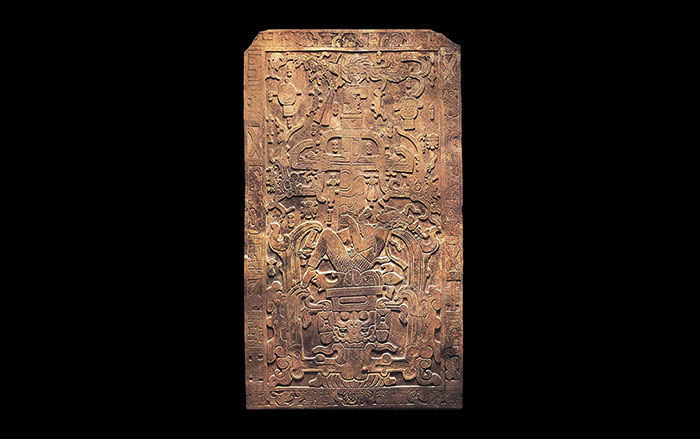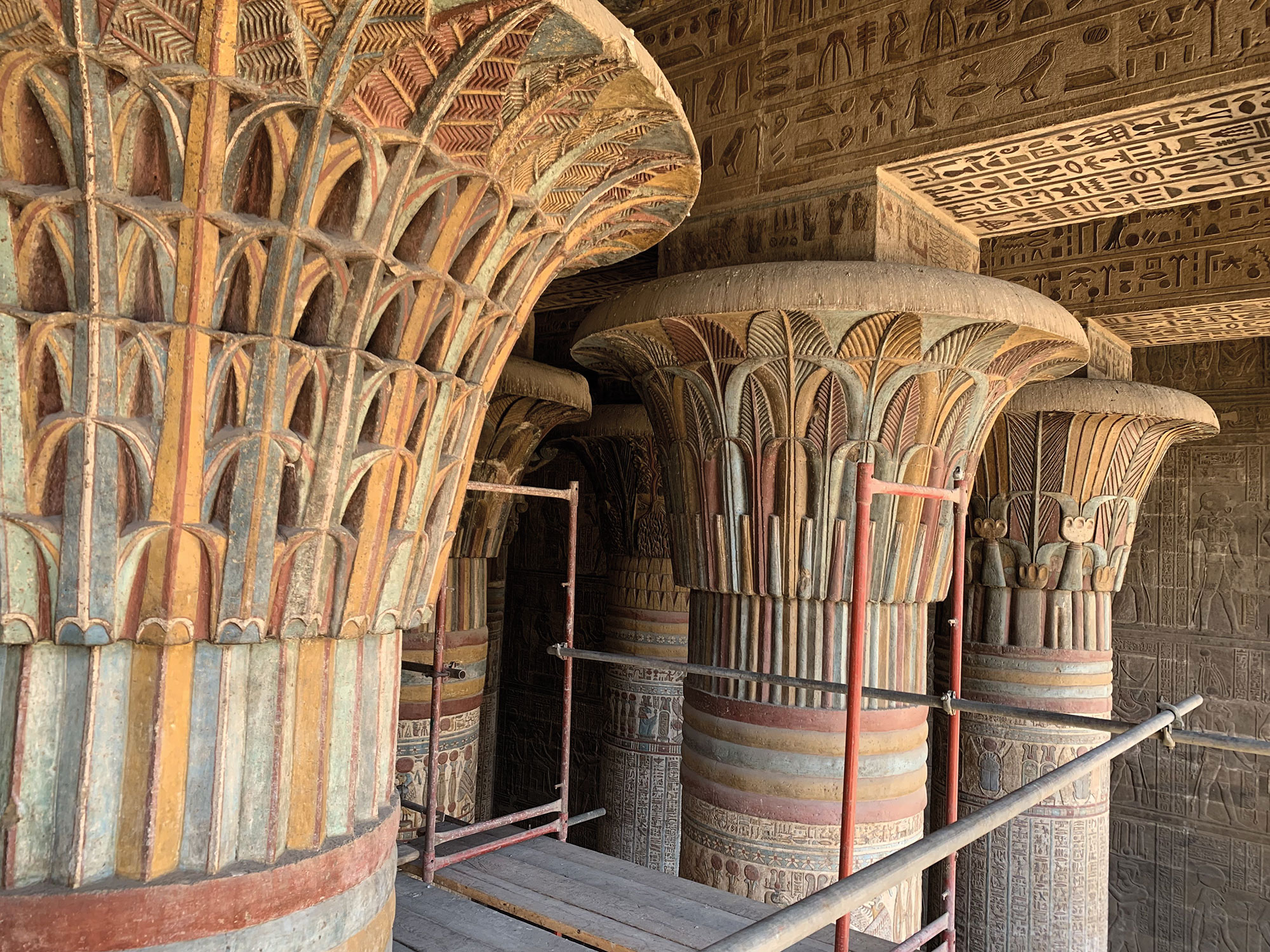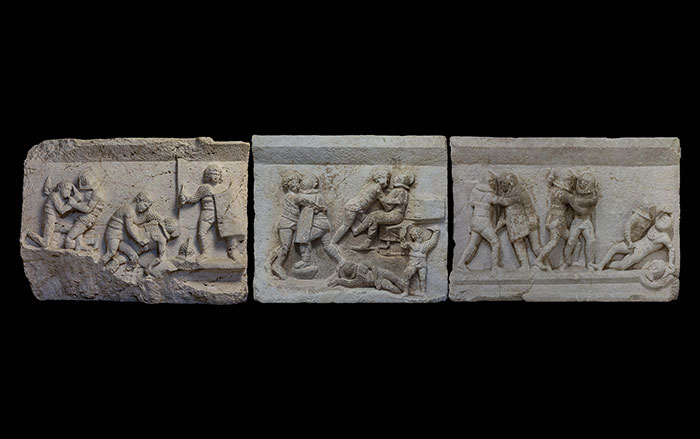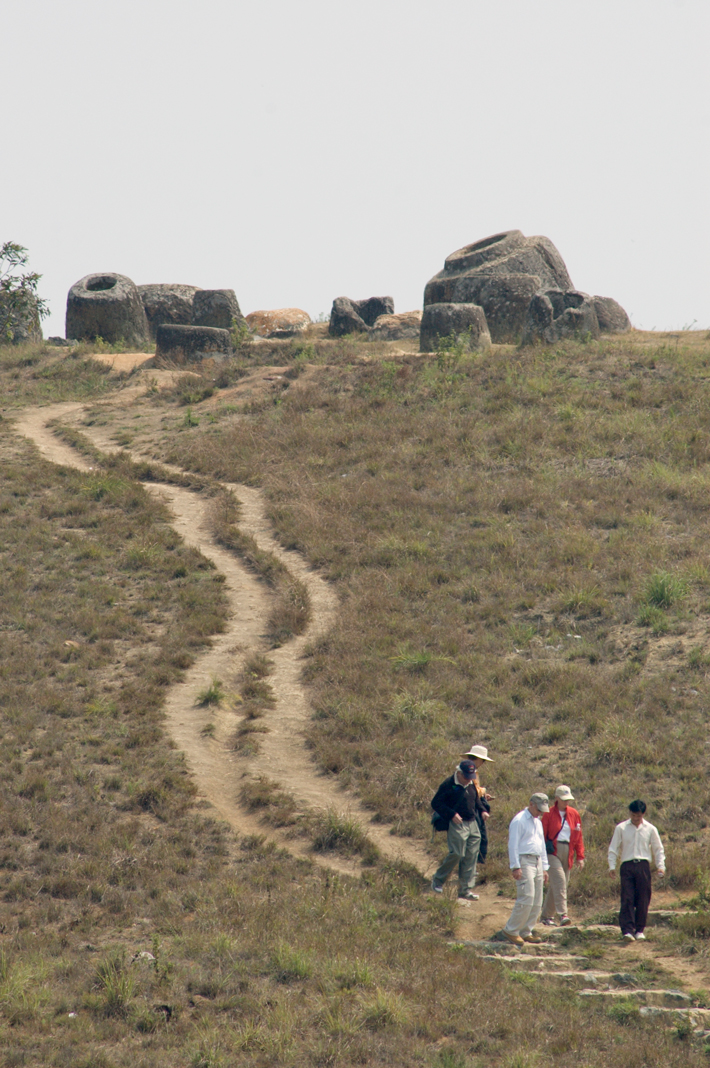
I’m following Belgian archaeologist Julie Van Den Bergh around Laos’ remote Xieng Khouang Province. We’re inspecting giant ancient vessels, which are scattered through rice paddies, forests, and hilltops at more than 60 sites across what is known as the Plain of Jars. Archaeologists think the jars were mortuary containers, perhaps 2,000 years old. But no one knows for sure their precise age, who built them, or why. They are swathed in mystery and surrounded by unexploded bombs.
Xieng Khouang Province is one of the most heavily bombed places on earth. Between 1964 and 1973, the United States dumped four billion pounds of bombs on the country in a “secret war” against Pathet Lao and North Vietnamese communists. Up to a third of them never exploded, and they litter the land today. While generally safe to tread upon, buried UXO (unexploded ordnance) can detonate when an erratic fuse is inadvertently triggered. The earth around here is dangerous to farmers plowing fields, children staking buffalo out to graze—and to archaeologists.
The jars are huge, up to nine feet tall, the largest weighing 14 tons. Most are carved of sandstone, others of granite, conglomerate, or calcified coral. Some are round, others angular, and a few have disks that appear to be lids. Tools and human remains found inside and around the jars suggest their use and manufacture spanned centuries. The bulk of material dates from 500 B.C. to A.D. 800, and additional carbon dates are expected this summer.
Archaeologists are certain the Plain of Jars is one of Southeast Asia’s most important archaeological sites—but it is one with more questions than answers.
French archaeologist Madeleine Colani pioneered research in Xieng Khouang in the 1930s. She found jars with cremated human remains and a nearby cave with burned bones and ash. Colani speculated the cave was a crematorium, the jars were mortuary vessels, and the fields were ancient cemeteries. Today, more than 2,000 jars have been identified across the province.
These archaeological treasures sit in one of the world’s poorest regions. That’s why Van Den Bergh, a UNESCO consultant from the Hong Kong–based Archaeological Assessments, is here. She hopes to turn the Plain of Jars into a UNESCO World Heritage site. The UNESCO-Lao Project to Safeguard the Plain of Jars aims not only to protect the vessels but to rehabilitate this remote province by clearing bombs, restoring agricultural lands, and promoting tourism.
A specialist in geoarchaeology with a decade of experience in Asia, Van Den Bergh has worked in Laos on six-week stints for four years now. In conjunction with the Lao government and a geographer from Bangkok, the project includes training Laotians to recover, record, and store archaeological material; create a precise map of the jar fields; and identify key areas for preservation and tourism development. The project also enlists local villagers to help with these tasks and involves the British-based Mines Advisory Group (MAG), a non-governmental organization hired to remove explosives from the most popular jar sites.
Some dub the Plain of Jars “the world’s most dangerous archaeological site,” and Van Den Bergh readily agrees. While archaeologists occasionally encounter UXO in war-torn countries and military testing grounds around the world, perhaps no archaeological site is as contaminated as the Plain of Jars. Two archaeologists conducted limited excavations in the 1990s without incident, “but that’s just luck,” Van Den Bergh says. “I’ve come home from surveying and thought, I’m happy to be getting into the car and coming home.”

My husband, Jerry, and I first visited Xieng Khouang in 1998. Back then, the capital, Phonsavan, was a Wild West sort of town with a main street of mud, on-again off-again water, and equally unreliable electricity. You could count on three fingers the tourists arriving each day. We stayed at a dimly lit guesthouse with a lobby full of bomb casings, mortar shells, grenades, and guns. Back then, we knew UXO still polluted the ground. But we didn’t know the jar sites remained riddled with bombs or that UXO continued to kill villagers every week in Xieng Khouang. And we didn’t know our guesthouse displayed four live bombs. (No worries now, MAG removed them.) When we arrive in Phonsavan this time, it’s still a dusty cow town, but the nights are ablaze with fluorescence, cheap restaurants and guest houses line the streets, and tourists from all over the world fill them.
Van Den Bergh drives us half an hour outside town, over a bone-rattling road, to a wooden house where MAG bases its operations. There, we meet Stuart Broome, the jovial ex-military man from Australia who heads the clearance team. The staff, about two dozen strong, are celebrating. Beer is flowing, music is thumping. A week ahead of schedule, they’ve just finished clearing Jar Sites 1, 2, and 3, the most popular tourist stops, each within a 45-minute drive of Phonsavan. Visitors now can safely explore those sites, provided they stick within MAG’s red-and-white concrete markers.
“Tourists come unaware of how dangerous Xieng Khouang is,” Van Den Bergh says. The jars have attracted travelers as long as Laos has, but many recent visitors never knew they were crossing contaminated land. Some local guides mistakenly told their guests all was safe and clear long before it was. Here, the ordnance problem isn’t visible, as it is in neighboring Cambodia, where land mines have left thousands of amputees. If UXO blows, “it’ll just kill you,” Broome says. No limbs lost, no person left. Nothing to illustrate the danger.

There is no reliable tally of UXO victims, but experts hear of at least one a week. They admit that’s probably low. Broome tells us of 11 accidents the week before we meet, “that we know of.” There were four two weeks before that, “that we know of.” But later we learn of eight more, for a total of 12. “That we know of” is an oft-used qualifier here.
MAG’s clearance records are staggering: Since work started in July 2004, the team has successfully removed and destroyed 127 pieces of UXO, cleared six acres, visually searched 55 acres, and found 31,814 pieces of scrap metal. And that’s just Site 1.
Finding explosives—using a variety of metal detectors covering 15-inch to seven-foot swathes—is a scrupulous task. Workers move back and forth, up and down a grid of red-rope lanes, detectors in hand. Each signal is marked with a red chip, and each chip is investigated by a technician with a shovel. They always dig down and toward the source, starting half a foot back. “We don’t dig on top,” Broome explains, “because that could cause UXO to blow.” UXO that is safe to move is stored until each Friday, when MAG detonates the entire week’s cache.
“It’s really similar, archaeology and bomb disposal,” Van Den Bergh wryly explains. When MAG clears a site, all the scrap metal is plopped in a bucket. Broome is first to peek at the findings, and Van Den Bergh’s quick to follow. Both are curious about the bucket, because its contents can tell a story about the site, either through bomb fragments or metal artifacts.
Broome and I examine the bucket one morning: a projectile fragment, cartridge cases, barbed wire, cans. I pick up a piece. “It’s a cartridge case from a recoilless rifle,” he says. He ogles an aluminum bit. “I think it’s part of a rocket motor.” It was all found in the parking lot at Site 3.

One bright Saturday, Van Den Bergh leads us through Site 1, pointing to hundreds of jars, scattered over parched grasslands and rolling hills just outside of town. A few cows graze through the area. Western tourists trundle downhill, ignoring the MAG markers; Laotian kids scramble uphill, doing the same. It will take time for people to learn.
We walk from jar to jar, each in small clusters. Van Den Bergh only has permission to survey on site. “All our excavations are connected to the MAG excavations,” she explains. “We don’t have permission to excavate for research.” She suspects the ground below our feet is rife with archaeological information—perhaps tools, burial urns, bones, or charcoal that could more precisely pin a date or offer conclusions on the historical background of the site. But Van Den Bergh is here solely to help prepare the sites for nomination for World Heritage status—taking inventory, mapping the jars, and creating a database. Working with MAG provided a bonus, the chance to see below the surface. “While they dig, we collect the information,” she says.
In fact, the jars have not been studied much. “Archaeologically, Laos is almost terra incognita,” writes Thongsa Sayavongkhamdy, the country’s only certified archaeologist and one of few to have excavated the jars. He, like Van Den Bergh, relies heavily on Colani, who documented her findings in two massive volumes titled The Megaliths of Upper Laos. Seventy years later, they remain the primary source on the jars.
The Plain of Jars seems to coincide with the Khorat Plateau in Thailand and the North Cachar Hills of India, where jar burials have also been found. These were transformative times, some 2,000 years ago, of agricultural advancement, metal manufacturing, religious expansion, widening Asian trade routes, and the societal precursors to urbanization. Colani speculated the Plain of Jars lay at an important intersection of trade routes that stretched, perhaps, from India to Vietnam.
She found beads and bronze and iron tools. The cave she discovered on Site 1 has blackened walls and two chimney openings that signaled to her that bodies had been cremated here before placement inside the jars.
Japanese archaeologist Eiji Nitta excavated some of the jars in 1994, and Thongsa followed a couple of years later. Both found burial pits containing human bones among the jars, and both concluded the sites were used for secondary burials. Van Den Bergh wonders about the archaeological discoveries over time: Colani found burned bones; Thongsa and Nitta found unburned. Did they stem from different periods? Were they halfhearted cremations? It seems the deceased was either buried or put in a stone jar for defleshing. Then the bones were either cremated or placed directly into an urn and buried. But questions nag her. Nitta found an urn with human bones and teeth beneath a jar at Site 1. It looked to him like tenth-century pottery from the Khmer Empire, and he concluded the stone jar directly above this urn could be no older than that. If so, that would make the jar 1,000 years younger than previously thought. Van Den Bergh doesn’t dispute this date but thinks the jar sites were occupied and used over many centuries.
Nitta, who returned to Japan, has sent his reports to Van Den Bergh—but she has not been able to reach him since. She has spoken with Thongsa several times, but he now studies in Australia and their work at the jars has yet to coincide. (He declined to be interviewed for this article.) Furthermore, many of Colani’s artifacts have disappeared from Laos over the years. So Van Den Bergh plugs along with what she has.
She questions villagers, hoping they’ll know something about the jars. But they always return to the same legend of an ancient king named Khun Cheung, an epic battle against an evil enemy, and a grand victory celebrated with copious quantities of alcohol some 1,500 years ago. The jars, they say, stored tons of lao lao, a hammering rice whiskey still enjoyed today.
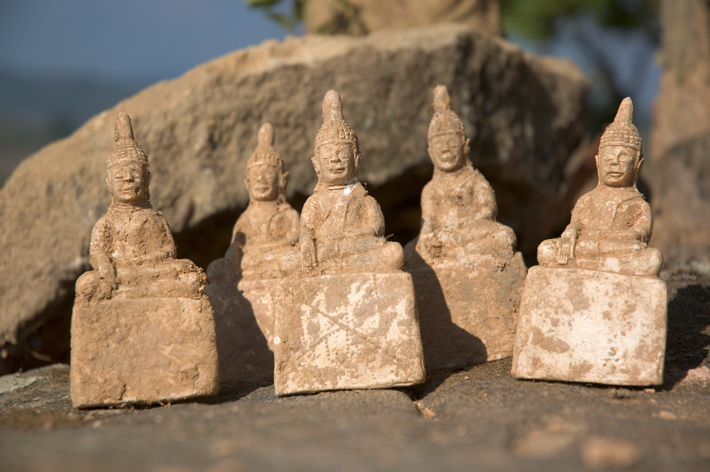
Van Den Bergh doesn’t discount this theory. Like any good Belgian, she likes her beer. When people die in Belgium, “it always involves lots of drinking,” she says. “So I can understand lots and lots of lao lao on a grave site.” (Though she doubts the jars were fermenters.)
As we continue touring Site 1, she points toward a zigzag of war-era trenches, to the bottoms of bomb craters where villagers dig for scrap metal, to a cavity in the hillside once used as a tank position.
She points to broken jars, a cause of consternation. They’ve been bombed and looted. Cows rub them, tourists climb them, trees straddle them. Villagers fashion the jars into water troughs or knife sharpeners. “Between the war, cattle, people, and trees, we are losing a lot,” she says. The weaker the jars get, the quicker they topple.
So she has a few plans. A bamboo fence will enclose some of the jars to deter cows, but she doesn’t want an overly restrictive situation. After all, part of the charm is that people can walk freely among the jars. But the cows must go, and so must some of the trees. “People come up here and picnic,” she says. “It’s just not acceptable.... We don’t want people to stay on site. We just want them to visit.”
In fact, Van Den Bergh wants more visitors. About 9,000 traveled to Site 1 last year from all over the world, but only a third of those reached Site 2, and fewer yet Site 3, which lies farther outside town. Van Den Bergh hopes tourism can spur the local agrarian economy, which affords most people less than a dollar each day. Site 1 is run by the government, but at other sites surrounding villages get half of the 7,000-kip (70-cent) entrance fees. Van Den Bergh hopes new jar sites will open soon, though “they’re not safe, of course.” They haven’t been cleared of UXO. Funding for MAG’s role in the project ended with clearance for Sites 1, 2 and 3.
Van Den Bergh’s is a shoestring operation, evident as soon as we enter her office. It sits on the second floor of a wooden building, a rustic work room with a back half stocked with shelves and metal trunks. Her face brightens as she reveals her treasures, collected from various sites, packed in plastic bags and acid-free paper: pottery sherds, a stone adze, a bugle (presumably French or Chinese, left in a war-era trench), a small Buddha, six metal knives, and tools made of flaky white stone.
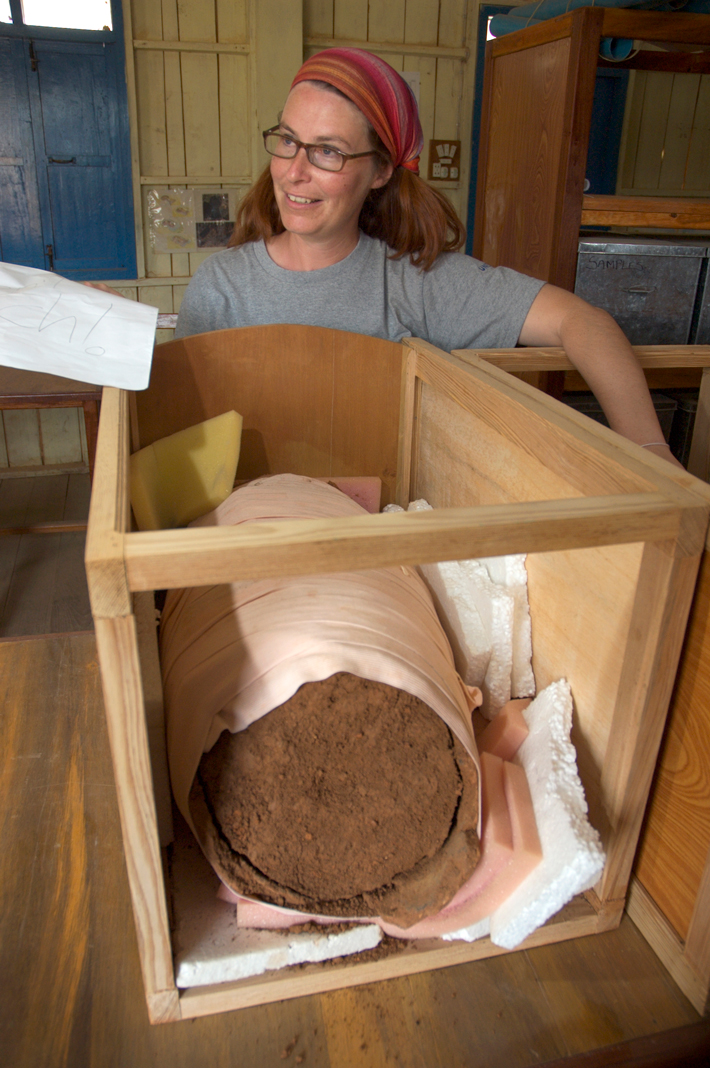
Then she beckons to the back, smiling: “Our pride and joy!” There, wrapped gingerly in Ace bandages and foam, packed in wooden crates, are two urns found in a Site 1 trench dug during UXO clearance. They’re about two feet tall, brown, and coated in resin, and they look like bombs—which is what Van Den Bergh was told when she took one to the hospital for x-rays. They also resemble the urn Nitta found with bones. Van Den Bergh’s pots are stuffed with soil, too fragile to empty, but the x-rays revealed a possible bone fragment inside. Someday, she’ll figure a way to get at the contents.
But she doesn’t have the money right now. UNESCO is paying $275,000 for the project, but that includes overhead and fund-raising costs. Only about half that amount reaches Van Den Bergh in the field.

A young boy in training to be a monk stands next to a jar at Site 3.(Jerry Redfern)
A few years back, project members started going village to village asking, Do you have jars? If so, they could attract tourists and money. Van Den Bergh still crisscrosses the province, greeting villagers and sitting for hours on wooden floors in homes on stilts. She is accompanied by government officials, and the meetings require exhaustive explanations: what the jars mean to archaeology, why tourists are interested, how tourism might help villagers. The jars are valuable relics, she explains, and UNESCO hopes to protect them as World Heritage—a status afforded to few.
Villagers usually don’t think much of the jars—they’re just rocks in the backyard. But once they get the idea that the jars are really important, they start talking about “new” jars. They had always been there, but no one realized they mattered.
We attend one of these meetings, in Na Xaytong village, an hour’s drive from Phonsavan. Chan Mootee, an elder, says the villagers here attribute healing qualities to the jars, and they pour jar water over the heads of ill children. Many years ago, he says, village monks rolled a jar to the temple for use as a water basin. But many people quickly grew sick, so the monks returned the jar to its original site.
When all the stories have been told, we gather for a feast of cabbage soup, boiled chicken, green-papaya salad, and a tray of fried innards in congealed duck blood—which we forgo. But what comes next, no one can avoid: the lao lao. Round and round the room it goes, several sherry glasses of firewater offered in an ancient tradition of hospitality and celebration.
That meeting is a prelude to a long hike to a survey site near a Hmong village called Ban Phakeo—a place with many jars but little in the way of tourism development. It’s a half-hour trudge downhill until the trail crosses a rickety bamboo bridge and makes a sharp upward turn. We see miles of blue-green mountains in hot haze. “I’m not tired,” Van Den Bergh pants, after another 90 minutes hiking through the sweltering jungle. “I’m just dead.”
Ban Phakeo is a collection of wooden homes, most with earthen floors, thatch roofs, and cluster-bomb casings for planters and feed troughs. The one-room schoolhouse has a bell made from bomb scrap, and the walls are decked with posters showing kids proper behavior around UXO: Don’t stake your buffalo to the ground; tie it to a tree instead. Never touch UXO. Tell an adult if you see something suspicious.
Farther uphill, another half an hour away, there are nearly 400 jars toppled in the forest, covered in mosaics of green and white lichens. The team quickly gets to business, stretching a tape measure from jar to jar, numbering, measuring, and photographing details. We spend two days among these ancient vessels, and the team works diligently amid scrub brush and trees, avoiding thoughts of UXO. Nothing here has been cleared.
It’s amazing, these jars sitting in the woods, on a windy hill. I catch Van Den Bergh in a moment of reflection, and she offers a pensive sigh. “They’re beautiful, aren’t they?” It is, really, the only imaginable comment. The beauty of these magnificent jars is indisputable; their value to archaeology is certain. These things are known. But for now, little else about the jars is.
Editor's Note: Originally published in the July/August 2005 issue
Video: Plain of Jars Mystery
Photojournalist Jerry Redfern recently accompanied a team of archaeologists as they excavated at the Plain of Jars in Laos. This enigmatic landscape is filled with thousands of massive stone vessels, some fashioned more than 2,500 years ago. Redfern’s video explores how the team is searching for clues about who created these mysterious jars and what they were used for.




